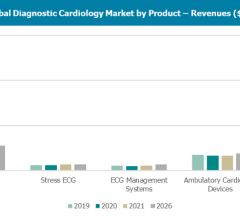
February 9, 2016 — Mount Sinai Heart is undertaking a three-year study to determine whether a workplace-based lifestyle intervention, accompanied by imaging data, will reduce the prevalence of cardiovascular (CV) disease risk factors related to lifestyle.
The study, known as TANSNIP-PESA, will be led by Valentin Fuster, M.D., Ph.D., director of Mount Sinai Heart and physician-in-chief of The Mount Sinai Hospital.
“Cardiovascular disease is the leading cause of death worldwide and early prevention is important for health gains and for cost reduction. I fully expect that individual awareness of cardiovascular disease based on imaging, accompanied by a comprehensive three-year work-based lifestyle intervention, will lead to a reduction in the prevalence of CV risk factors related to lifestyle,” said Fuster.
The population for the TANSNIP-PESA consists of people 40 to 60 years old and who are employees from a Spanish corporation. Employees will be divided into two groups. One group will comprise employees with high imaging-defined CV risk and a second group will comprise those with low imaging-defined CV risk. In both groups, participants will be randomized to either receive the comprehensive three-year worksite lifestyle intervention or standard occupational healthcare.
Employees in the workplace-based lifestyle intervention program will receive 12 personalized lifestyle counseling sessions spread over the three-year period, a Fitbit personal fitness monitor to self-monitor physical activity and an Ergotron sit-to-stand station. Data will be collected at baseline, at year one, at year two and at year three.
The primary outcome measure is the newly developed FUSTER-BEWAT score, which consists of blood pressure, physical activity, sedentary behavior, body mass index, fruit and vegetable consumption, and smoking. The researchers will also measure secondary outcomes such as changes in lifestyle, smoking, body weight, diet, vitality and quality of life, and risk factor profiles, as well as changes in blood biomarkers, and work-related outcomes such as work productivity and absenteeism.
The researchers hypothesize that the level of compliance with the lifestyle intervention will be higher in the group with high imaging-defined CV risk, compared to those with low imaging-defined CV risk. They will also review the cost-effectiveness of the intervention, compared with standard care, from both the societal and employer’s perspective.
This study is the first in a series of four known as the TANSNIP (Trans-Atlantic Network to Study Stepwise Noninvasive imaging as a Tool for Cardiovascular Prognosis & Prevention) Program. The four studies are designed to understand atherosclerosis in different populations, at different levels of risk and in different settings. The other TANSNIP studies include TANSNIP-H2H (heart to heart), which includes older patients and employs cutting-edge technology and cognitive dysfunction; TANSNIP–BioImage, which explores atherosclerosis progression in middle-aged people in Chicago and Florida; and TANSNIP-Genomics, which examines genomics, proteomics and metabolomics across the populations of the other three TANSNIP studies. TANSNIP seeks to develop lifestyle-changing tools based on non-invasive imaging results of subclinical atherosclerosis presence.
The TANSNIP-PESA project is an international initiative that is being conducted through partnerships with Centro Nacional de Investigaciones Cardiovasculares, the Icahn School of Medicine at Mount Sinai, the Framingham Heart Study, and the VU University Medical Center in Amsterdam.
The TANSNIP Program is funded by a $5 million grant from AstraZeneca.
For more information: www.mountsinaihealth.org


 August 15, 2024
August 15, 2024 








